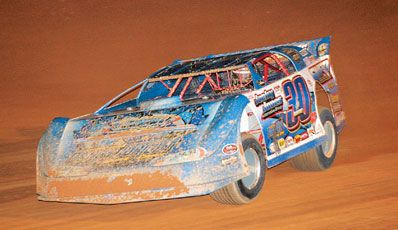
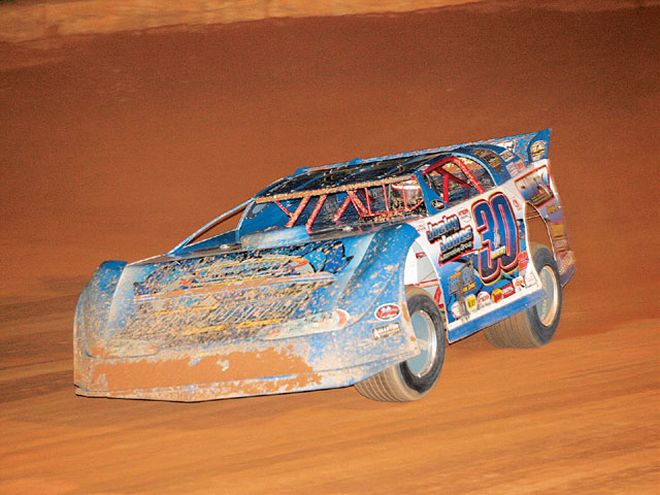
Engine and chassis guys often don't want to hear it, but in many ways the tire specialist is right when he says that those four black rubber doughnuts are the most important things on any race car. It's true because the tires are the only things connecting your race car to the track, and their ability to maintain traction when accelerating, braking, and turning determines how quickly you can make a lap. So finding ways to get better traction from your tires helps efficiently translate power into speed.
Many tracks, particularly those hosting Late Models and Super Stocks, still allow race teams to modify their tires to enhance traction. You can alter your tires chemically (by using a traction compound to soften the rubber) or physically. In this article, we will concentrate on the physical aspect of enhancing traction. Chemically altering racing tires is still done, but with so many compound choices available, many professional racers say that the old science of soaking tires is no longer a necessity.
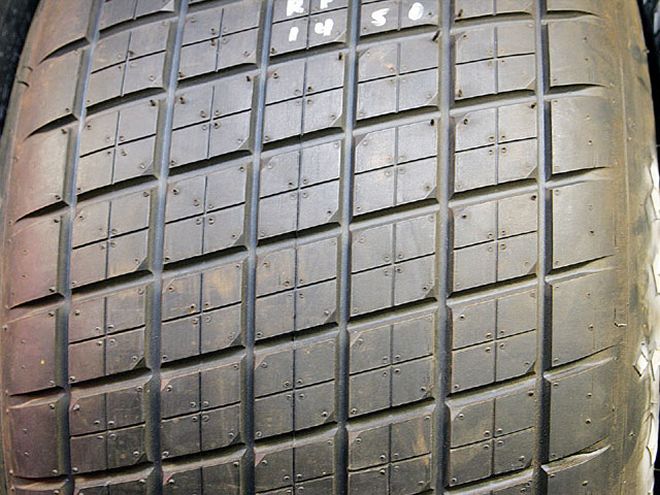 Here's an unmodified Hoosier tire for the right-front wheel. It already has a good tread design that provides lots of edges in both directions to increase traction on dirt racetracks, but it can be improved.
Here's an unmodified Hoosier tire for the right-front wheel. It already has a good tread design that provides lots of edges in both directions to increase traction on dirt racetracks, but it can be improved.
There are three major components when it comes to physically altering a dirt tire. They all, however, are designed to reshape the tire's surface or tread pattern. Grooving is the process of cutting new groups into the tread pattern. The depth and width of the grooves can vary depending upon the tool used and the desires of the tire specialist. Siping a tire is similar, except it involves the use of a narrow blade that only cuts a small slit in the rubber instead of a groove that leaves a channel in the tread pattern. Grinding is the third option, and it is the process of using a powered sander to remove the first few thousandths of an inch of rubber from a tire. Using all three processes, you can dial in a set of tires to the conditions of your racetrack.
Grooving
The process of grooving and siping race tires is a lot like judging a beauty contest: Everybody generally agrees on what works best, but there are many different ideas about the finer details. We spoke with Lance Wright, tire specialist for Barry Wright Race Cars. Lance works with Barry Wright's house car, which is driven by Dennis "Rambo" Franklin, who is the 2006 Southern All-Stars Dirt Late Model touring series champion.
"Generally, the more edges you can put in a tire, the more grip it will have," Wright explains. "You want to add grooves to a tire when the track is muddy. You want the tire to sling the mud off before it spins all the way around and makes contact with the track again. Grooving the tire helps sling the mud off."
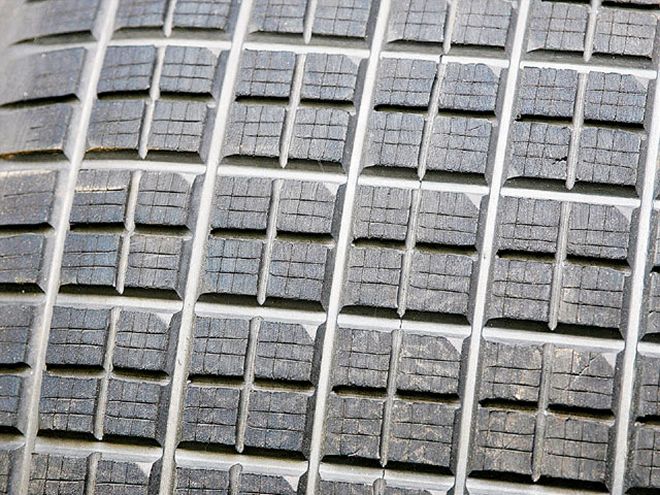 This is a Hoosier rear tire that Wright has modified. It differs in stock form from a front tire because the tread pattern is squared up. Wright cut two grooves 90 degrees from each other through each square tread and then bisected each of the four blocks in the tread with four sipes (two horizontal and two vertical). The extra edges created by the grooves and sipes not only increase traction, but also help the tire reach prime operating temperature more quickly.
This is a Hoosier rear tire that Wright has modified. It differs in stock form from a front tire because the tread pattern is squared up. Wright cut two grooves 90 degrees from each other through each square tread and then bisected each of the four blocks in the tread with four sipes (two horizontal and two vertical). The extra edges created by the grooves and sipes not only increase traction, but also help the tire reach prime operating temperature more quickly.
Grooving requires a special tool that heats a U-shaped blade. The heat helps melt the tire rubber so that the blade makes a clean cut in the tire.
Siping
Siping is similar to grooving in that it is a process of cutting the tire, but a sipe is a slit that does not create an open channel in the tire rubber like a groove does. Sipes are normally cut with razor blades, and although they may not look like much, they can actually have a large influence on how the tire handles.
"Edges not only increase traction, they also help the tire heat up and cool down faster," Wright explains. "So siping a tire will help it heat up more quickly and reach a good operating temperature in fewer laps. This can help you get a jump on other cars on the racetrack if your tires are gripping better, sooner."When track conditions are ideal, Wright will spend more time siping than grooving. This is because siping adds edges to a tread without actually removing any rubber. With siping, you can put the same amount of rubber on the track while also adding edges. Because they are narrower, you can also run three or four sipes where you would only have enough room for one groove.
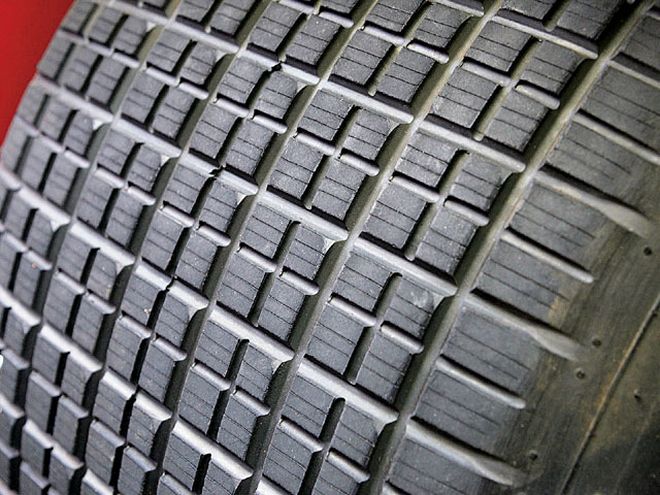 Here's another version of the same-style rear tire. This tire is prepared for conditions in which gaining side bite is not as much of a concern or the track is very rough and tire wear must be minimized. The same groove pattern is here, but the sipes have only been cut across the tread of the tire (not around the circumference) to maximize forward bite. When siping a tire, Wright says it is important to keep the cuts as parallel as possible.
Here's another version of the same-style rear tire. This tire is prepared for conditions in which gaining side bite is not as much of a concern or the track is very rough and tire wear must be minimized. The same groove pattern is here, but the sipes have only been cut across the tread of the tire (not around the circumference) to maximize forward bite. When siping a tire, Wright says it is important to keep the cuts as parallel as possible.
"You don't want to groove or sipe a tire deeper than the tread depth," Wright adds, "but track conditions can also affect your depth. If the track is hard and wears tires out quickly, you do not want to cut your grooves or sipes as deep. This will help keep your tires from chunking, which is when the track tears out chunks of rubber from the treads."
Wright also points out that the direction you groove or sipe depends on the corner of the car on which the tire will be mounted. For example, cutting sipes along the circumference of a rear tire will offer no performance advantage for acceleration. Sipes and grooves on the rear tires should be cut across the tire so that they are perpendicular to the rotation of the tire. That way, the grooves will help forward bite and braking. If he feels that gaining side bite will be important, Wright will sometimes add circumferential sipes to the right-rear tire.
On the front tires, the needs are different. Getting the car to turn is more important, so the priority when grooving and siping should be circumferential cuts. These will help the tire "dig in" when the driver turns the steering wheel.
When grooving and siping, you should always be careful about the density (or spacing) of your cuts. Too many cuts will weaken the tread and make a tire-especially the rears-more likely to chunk. Running a tire that's too soft on a high-grip track will make a tire more likely to chunk. Cutting too many sipes through the tread pattern will do the same thing. Hard edges, while they aid traction, also increase the probability of chunking. Chunking is costly in terms of traction, so it should be avoided at all costs.
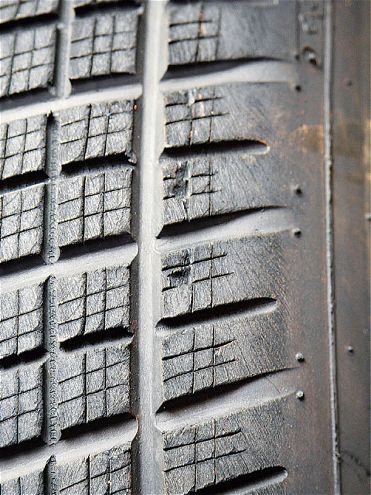 Here is a mild example of chunking, which is the term used to describe a rough track ripping chunks of rubber out of a tire's tread. Wright says if chunking becomes a problem at a track, try widening the space between your sipes.
Here is a mild example of chunking, which is the term used to describe a rough track ripping chunks of rubber out of a tire's tread. Wright says if chunking becomes a problem at a track, try widening the space between your sipes.
Sipes can be as close as 31/416 inch apart, but that distance must sometimes vary with different track surfaces and rubber compounds. It is important to make sure your sipe lines are as parallel as possible in order for you to make as many cuts as possible without getting sections too close together. Siping is a time-consuming and labor-intensive task, so you may want to consider special siping tools that can save you time and effort by making several cuts at once. One we've tried is Speedway Motors' Mega Siper, which can make as many as 14 cuts at once. The siper uses standard razor blades that are inexpensive and easily replaced so that it always makes easy cuts. Blades can be added or removed as necessary to set the spacing you want between cuts. Plus, since the siper keeps the blades aligned, you know that cuts made on the same pass will always be parallel.
Grinding
Grinding is significantly different from grooving or siping but no less important. Instead of changing the shape of the tire tread, grinding prepares the surface of the tread. This knocks off the "new" surface from a fresh set of tires to get to the good rubber, and also removes the outside work-hardened layer of rubber from a used tire.
Another useful purpose for grinding is to round off sharp groove edges to reduce the possibility of chunking. Wright does this by holding the grinder at a slight angle and moving it across the tire in the same direction the tire will be acted upon by the track. For example, for right-side tires, Wright grinds from the outside of the tire to the inside. The opposite is true on a tire mounted on the left side of the car. Since the car is always turning left, forces are acting on the interior sidewall and trying to push out. Because of this, Wright grinds outward from the inside edge of the tire. This helps to slightly round off the leading edge of the grooves so that they are less likely to be ripped off under side-loading when the car is hooked up well.
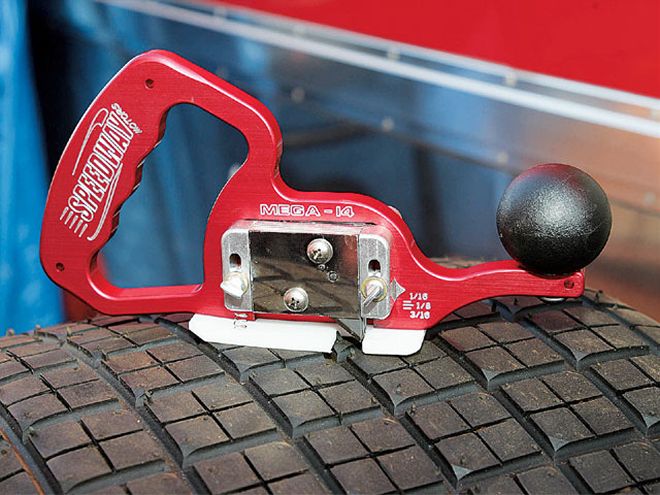 Siping is a difficult, time-consuming job. One of the best tools to make the tire specialist's life a little easier is Speedway Motors' new Mega Siper. It uses up to 14 equally spaced razor blades to make several siping cuts at a time, and the depth is also adjustable. The design of the tool reduces the strain on your arms when siping tires for several hours straight.
Siping is a difficult, time-consuming job. One of the best tools to make the tire specialist's life a little easier is Speedway Motors' new Mega Siper. It uses up to 14 equally spaced razor blades to make several siping cuts at a time, and the depth is also adjustable. The design of the tool reduces the strain on your arms when siping tires for several hours straight.
Chunking is also a problem for the rear tires when the they are under acceleration and the car has a lot of forward bite. Because of this, you may need to grind the rear tires twice-once laterally to prevent the tread from chunking under side-loading, and again around the circumference of the tire to smooth the leading edge of the treads so that they won't chunk under acceleration.
Finally, if you reuse race tires, you may notice that the leading edge of the tread will wear more than the trailing edge. Reusing a tire in this condition will actually reduce the surface area of the contact patch, or the portion of the tire actually contacting the track surface. Wright says that with careful use of the grinder, you can smooth out undulations in a tire to return it to like-new status.
Wright warns that you have to avoid grinding grooves or low spots into the tire that can harm traction. Different tire specialists prefer different tools, but Wright uses a powered sander with a variable speed control and replaceable pads. He says softer tires require slower sander speeds to keep the tire (and pad) from gumming up. For more purposes, he uses sanding pads that have between No. 36 and No. 40 grit.
Finally, when preparing a set of tires for a night of racing, be prepared to spend some time. Wright says properly preparing a new tire (grooving, siping, and sanding) can require as much as two hours. That means eight hours, or a complete work day, for a set of four tires. "It can be a pain when it takes all day to get a set of tires ready," he says, "but you've got to be willing to do what it takes if you want to be fast." CT
Your tire choice is critical for traction on dirt, but the way you prepare them is just as important. Dennis "Rambo" Franklin drives the Barry Wright Race Cars house car and is the defending Southern All-Stars Dirt Late Model touring series champion. Tire specialist Lance Wright shared with us some of his tricks.
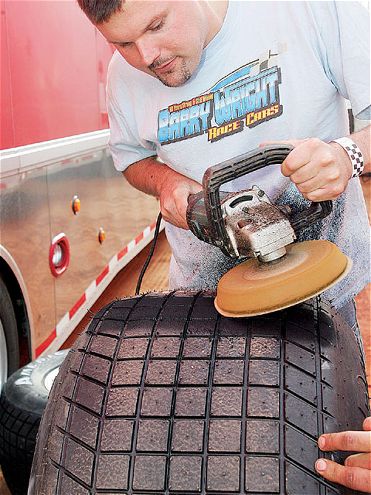
Wright grinds another tire. He always grinds in the same direction that a tire will see on the track. In other words, right-side tires are always ground from the outside sidewall to the inside, while left-side tires are ground from the inside sidewall to the outside. This softens the leading edges in the grooves so that they are less likely to chunk on the racetrack.